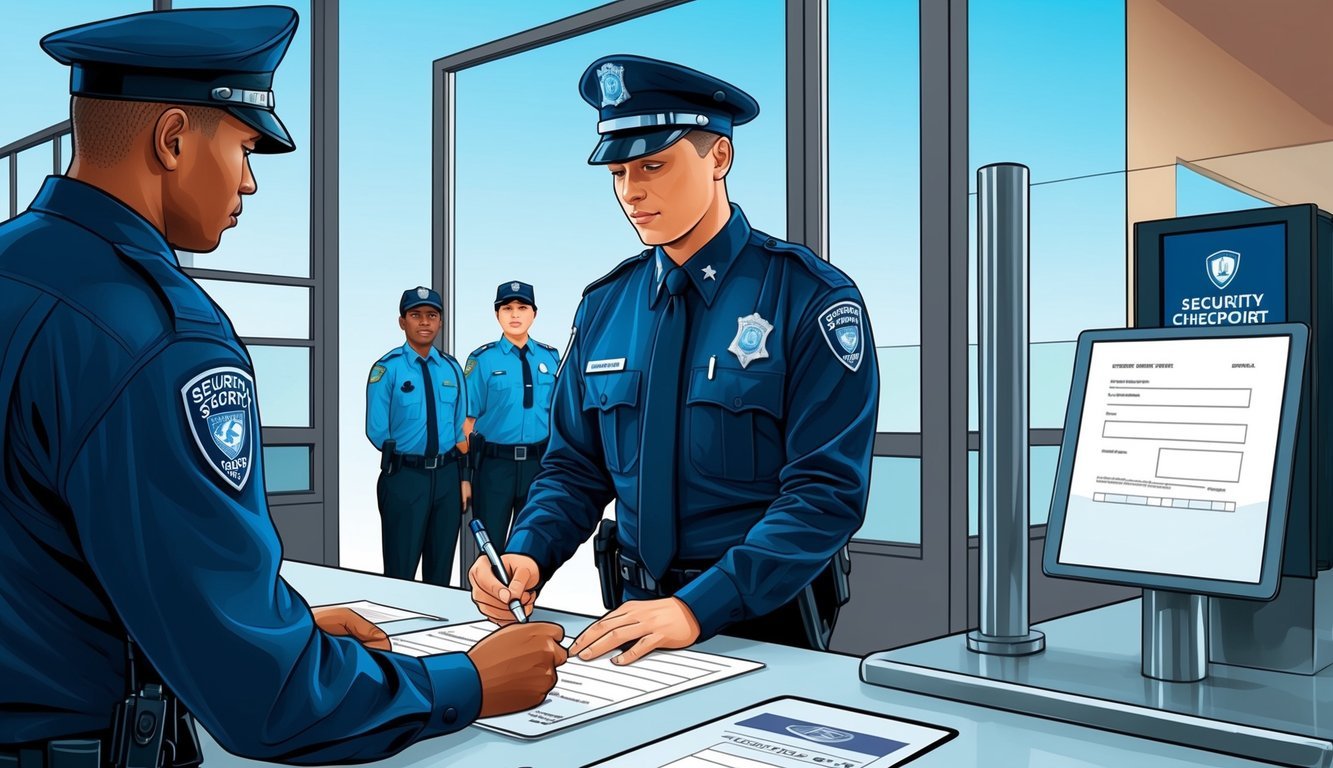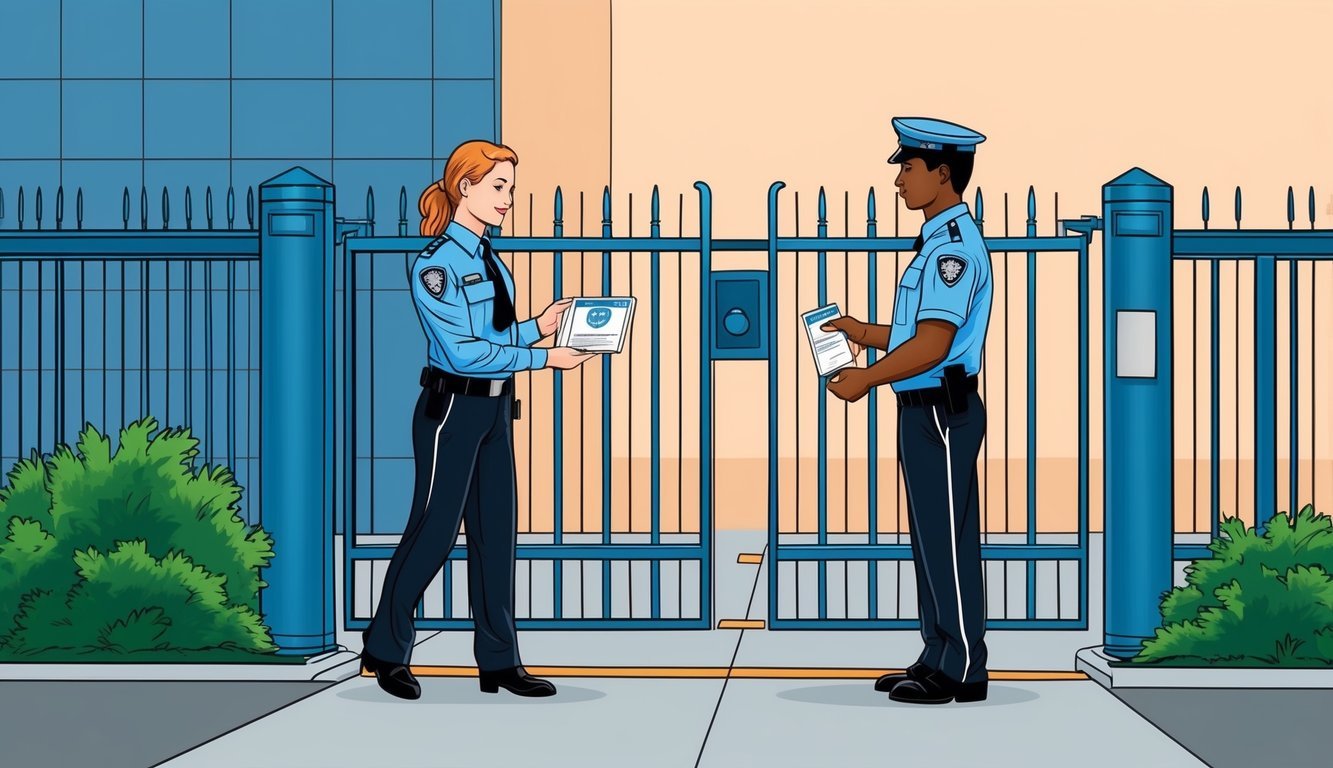Getting onto a military base can sometimes feel like trying to get into a VIP concert—if you’re not on the list, it can be tricky! But don’t sweat it; I’m here to help make the process a bit easier, whether you’re visiting family, attending an event, or working as a contractor.
alt=”A person at a desk, filling out a form with personal information and showing identification to a security guard at a gated entrance”>
First things first, you’ll need someone with base access to sponsor you and complete a background check. This process can take a few days or even weeks, so getting a jump on it is always a smart move.
You’ll need to fill out some forms and have your ID ready.
Each base has its own little quirks, but generally, they stick to the same playbook.
For instance, some bases might ask you to fill out a sponsorship form for everyone in your party who needs access.
It’s a good idea to check the specific base’s website or just give their visitor center a call for the latest scoop.
Key Takeaways
- Getting on base typically requires sponsorship and a background check.
- Start early—this can take longer than you might expect!
- Each base has its own policies, so always verify with them directly.
Preparation for Base Access

Prepping for base access is all about knowing what ID to bring and keeping a few important rules in mind.
It can really help things go smoothly.
Understanding the Real ID Act
The Real ID Act changed the game when it comes to military bases.
It introduced some new rules for IDs, and not all state IDs will cut it anymore.
You’ll want to double-check that yours is up to snuff before heading out.
Some states had a grace period to meet the requirements, but now most of them have caught up.
If your ID doesn’t make the grade, you might be turned away—definitely not a fun experience.
Better safe than sorry!
This act aims to make things safer by reducing the chances of fake IDs slipping through.
Knowing the ins and outs can save you time and hassle at the gate.
Types of Identification Cards and Their Requirements
Different types of IDs can help you gain access to a base, and each one comes with its own set of rules.
Here’s the lowdown:
- Driver’s license: Must be Real ID compliant.
- Passport: Always a go-to option, even for our international friends.
- Military ID: For active service members and their families.
- Department of the Navy Local Population ID: A must for certain workers and vendors.
Some bases may ask for a bit more paperwork, so it’s a good idea to check in advance.
And honestly, bringing backup ID can never hurt!
Oh, and don’t forget—your IDs need to be current.
Those expired ones? Nope, they won’t work.
Plus, some bases scan IDs, so make sure yours is in tip-top shape.
Access Procedures and Security Protocols

Gaining entry to a military base involves a few steps and requirements.
These checks help keep everyone safe while ensuring authorized folks can get in.
Registering for DBIDS
Ever heard of DBIDS? It stands for Defense Biometric Identification System.
It’s a big part of how bases maintain security.
To get registered, just swing by the Visitor Center with a valid ID.
They’ll take your picture and fingerprints, and the whole thing usually wraps up in about 15-20 minutes.
Once you’ve registered, you’ll receive a DBIDS card, which is like your golden ticket to the base.
Keep it safe—it’s your pass for easier access moving forward!
Having DBIDS in place helps track who’s coming and going, making everyone’s experience quicker and safer.
Checking In at the Visitor Center
The Visitor Center is your first stop when visiting a base.
Bring along a government-issued ID, like your driver’s license or passport, along with proof of your visit (like an invitation or a note from your sponsor).
It’s like getting a backstage pass!
The staff will check your ID and run a quick background check.
Once you’re cleared, they’ll hand you a visitor pass that outlines where you can go on base.
Remember, the Visitor Center has specific operating hours, so make sure you check those before you head over.
You might even need an appointment for certain visits!
Understanding the ‘Trusted Traveler’ Policy
Now, let’s talk about the Trusted Traveler policy, a great perk that allows some folks to bring guests onto the base.
It’s particularly handy for families and friends visiting.
Here’s how it works:
- A service member or DoD employee can vouch for up to 5 guests.
- The sponsor has to stick with their guests the whole time.
- Guests need to have a valid ID, but no separate background check is required.
This policy is fantastic for family events or when you’ve got visitors coming to see you.
Just remember, the sponsor is responsible for keeping their guests out of trouble!
Gaining Entry to Military Installations
Ready to roll? When it’s time to enter the base, head to the gate with your ID or visitor pass at the ready.
The guard will check it and might ask you a couple of questions.
If you’re driving, they might also do a quick inspection of your car—but that’s all part of the process.
Just follow their lead, and you should be golden.
Once you’re cleared, you can enter the base.
Make sure to mind the posted signs and speed limits—you’re on federal property now, after all!
If you need assistance, look for information kiosks or just ask any uniformed personnel.
They’re there to help make your visit smooth and safe.
Frequently Asked Questions
Let’s dive into some common questions about getting access to a military base as a civilian.
Here’s the lowdown:
What do I need to do to visit someone on a military base as a civilian?
If you’re a civilian looking to visit someone on base, you’ll need to snag a visitor pass first.
It’s best to reach out to the person you’re visiting for information about their base’s access procedures.
When you arrive at the visitor center, make sure you’ve got your proper ID in hand.
You might also have to go through a background check before getting your pass, so allow yourself some extra time.
Oh, and if you’re curious about military benefits, feel free to ask the staff there about how to sign up for military travel and other programs!
What types of identification are acceptable for entry to a military base?
Most bases will accept government-issued photo IDs, like your driver’s license or passport.
Some might require REAL ID compliant identification, though, so it’s wise to check the specific base’s requirements before you head out.
Are there any specific requirements for obtaining a military base visitor pass?
Generally, visitors need to fill out a few forms and show ID when they arrive at the visitor center.
You might also need information about the person you’re visiting.
A background check could also be part of the process at some bases.
Could there be any reasons why I might be denied access to a military base?
Yep, base access can be denied for various reasons, such as providing false information, having certain criminal convictions, or not meeting security requirements.
Keep in mind that each base has its own set criteria.
How can civilians apply for a Defense Biometric Identification System (DBIDS) card for base access?
If you need to access the base regularly, you can apply for a DBIDS card.
The process typically involves submitting an application, showing ID, and possibly going through a background check.
Each base has its own procedures, so be sure to check in.
Is it possible for a family member to live with a service member on base?
Absolutely! Family members can often live on base with service members as long as they’re registered as dependents and have the right ID cards.
Keep in mind that housing availability and policies can vary between bases.

